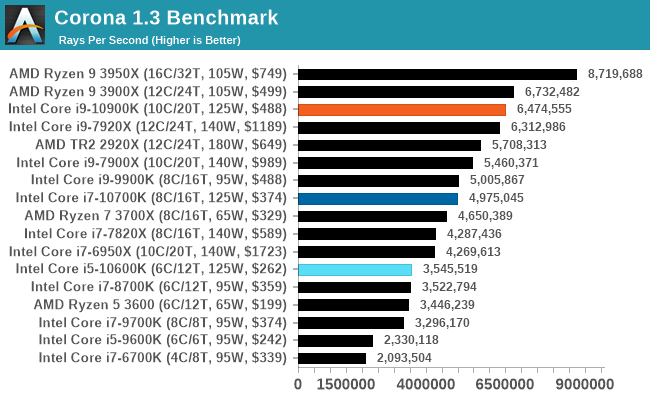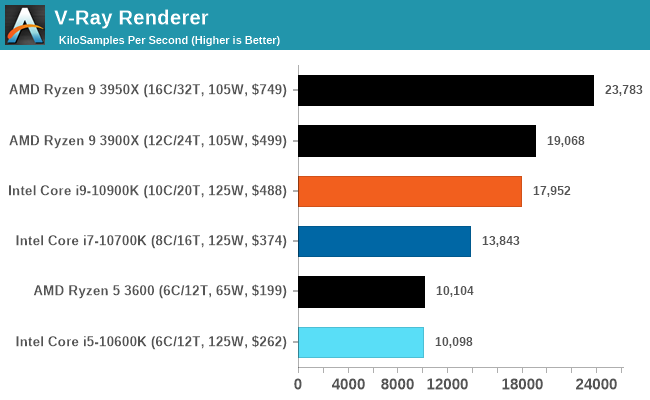The Intel Comet Lake Core i9-10900K, i7-10700K, i5-10600K CPU Review: Skylake We Go Again
by Dr. Ian Cutress on May 20, 2020 9:00 AM EST- Posted in
- CPUs
- Intel
- Skylake
- 14nm
- Z490
- 10th Gen Core
- Comet Lake
CPU Performance: Rendering Tests
Rendering is often a key target for processor workloads, lending itself to a professional environment. It comes in different formats as well, from 3D rendering through rasterization, such as games, or by ray tracing, and invokes the ability of the software to manage meshes, textures, collisions, aliasing, physics (in animations), and discarding unnecessary work. Most renderers offer CPU code paths, while a few use GPUs and select environments use FPGAs or dedicated ASICs. For big studios however, CPUs are still the hardware of choice.
All of our benchmark results can also be found in our benchmark engine, Bench.
Crysis CPU Render
One of the most oft used memes in computer gaming is ‘Can It Run Crysis?’. The original 2007 game, built in the Crytek engine by Crytek, was heralded as a computationally complex title for the hardware at the time and several years after, suggesting that a user needed graphics hardware from the future in order to run it. Fast forward over a decade, and the game runs fairly easily on modern GPUs, but we can also apply the same concept to pure CPU rendering – can the CPU render Crysis? Since 64 core processors entered the market, one can dream. We built a benchmark to see whether the hardware can.
For this test, we’re running Crysis’ own GPU benchmark, but in CPU render mode. This is a 2000 frame test, which we run over a series of resolutions from 800x600 up to 1920x1080. For simplicity, we provide the 1080p test here.
This is one of our new benchmarks, so we are slowly building up the database as we start regression testing older processors.

The Core i9-10900K scores 15 FPS at 800x600, which is just about playable.
Corona 1.3: Performance Render
An advanced performance based renderer for software such as 3ds Max and Cinema 4D, the Corona benchmark renders a generated scene as a standard under its 1.3 software version. Normally the GUI implementation of the benchmark shows the scene being built, and allows the user to upload the result as a ‘time to complete’.
We got in contact with the developer who gave us a command line version of the benchmark that does a direct output of results. Rather than reporting time, we report the average number of rays per second across six runs, as the performance scaling of a result per unit time is typically visually easier to understand.
The Corona benchmark website can be found at https://corona-renderer.com/benchmark

Blender 2.79b: 3D Creation Suite
A high profile rendering tool, Blender is open-source allowing for massive amounts of configurability, and is used by a number of high-profile animation studios worldwide. The organization recently released a Blender benchmark package, a couple of weeks after we had narrowed our Blender test for our new suite, however their test can take over an hour. For our results, we run one of the sub-tests in that suite through the command line - a standard ‘bmw27’ scene in CPU only mode, and measure the time to complete the render.
Blender can be downloaded at https://www.blender.org/download/

V-Ray
We have a couple of renderers and ray tracers in our suite already, however V-Ray’s benchmark came through for a requested benchmark enough for us to roll it into our suite. We run the standard standalone benchmark application, but in an automated fashion to pull out the result in the form of kilosamples/second. We run the test six times and take an average of the valid results.
This is another one of our recently added tests.

POV-Ray 3.7.1: Ray Tracing
The Persistence of Vision ray tracing engine is another well-known benchmarking tool, which was in a state of relative hibernation until AMD released its Zen processors, to which suddenly both Intel and AMD were submitting code to the main branch of the open source project. For our test, we use the built-in benchmark for all-cores, called from the command line.
POV-Ray can be downloaded from http://www.povray.org/

Interestingly the Core i9 with only 10C outperforms the 12C Ryzen 9 3900X here, likely due to the higher sustained frequency of the Intel chip. We clocked 220W on our Intel chip for this test however, well beyond the 120W of the AMD processor.












220 Comments
View All Comments
watzupken - Wednesday, May 20, 2020 - link
Sorry for typo, its a 28 core, not 20 core.blaktron - Wednesday, May 20, 2020 - link
No one else wondering how Ian manages to get only a 5% drop in performance going from h264 Faster to h265 Fast? That should be well over a 50% drop, and suggests he is running his HEVC tests with an H264 profile.Am I crazy here or is the idea that an 8 core CPU gets 200 fps h265/HEVC encoding just plain wrong?
WaWaThreeFIVbroS - Thursday, May 21, 2020 - link
This place is owned by the dudes running tomshardware, what do u expectIcehawk - Saturday, May 23, 2020 - link
I have asked numerous times how they get HEVC #s as they are almost quadruple what I get. 3900x gets in the 70s encoding and my 8700 was in the 60s. I can only guess they use the hardware encoders which isn’t how anyone who cares about quality is going to do it and doesn’t show the full cpu vs cpu difference, it shows the built in encoder. But Anand still thinks people who bother to read CPU reviews don’t use XMP.lucasdclopes - Wednesday, May 20, 2020 - link
"Intel's turbo has a recommended length of 56 seconds according to the specification sheets, and on our test system here, the motherboard manfuacturer is confident that its power delivery can support a longer-than-56 second turbo time. "So performance of those chips will have significant differences depending on the motherboard? Maybe cheaper boards will result in worse sustained performance then.
jcc5169 - Wednesday, May 20, 2020 - link
Intel fanboys are gasping for air, looking for excuses not to buy the obvious choice, AMDDannyH246 - Wednesday, May 20, 2020 - link
www.IntelTech.com does it again!! Every element designed to show Intel in the best possible way.How about this instead...
The Core i9-10900K's is priced so that its clear competitor is the Ryzen 9 3900X. However AMD offering is still >=15% cheaper, offers PCIe 4.0 compatibility, uses less power, is more secure and can be used on older, cheaper boards that also support the 16-core 3950X allowing for an upgrade path. The Core i9 is a moderately reasonable chip at best, however as it requires a new motherboard it is effectively a dead end.
vanilla_gorilla - Wednesday, May 20, 2020 - link
I always know it's a good review when half of the comments claim the author is an Intel shill and the other half claim they are an AMD shill.Beany2013 - Wednesday, May 20, 2020 - link
Ain't it beautiful?Honestly, I'm kinda surprised how well Intel has managed to maintain their performance on a pure math basis, but oh *goodness* that power usage.
I think things will get really interesting when intel hit the sub 10nm* process (by which time AMD should be on 5nm*) and we'll see how much fight both Intel and AMD both have.
That it means we can all get solid multicore, multithread (fucking finally) CPUs from both vendors at prices that can be described as 'not entirely crazy' is a win win no matter which side of the fence you're on.
Steven R
Beany2013 - Wednesday, May 20, 2020 - link
* yeah, nm is a bit of a poor measurement these days, but you get the idea.